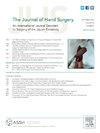在啮齿动物模型中,微钩神经连接器辅助聚乙二醇融合用于轴突连续性的即时恢复。
IF 2.1
2区 医学
Q2 ORTHOPEDICS
引用次数: 0
摘要
目的:本研究的目的是测试聚乙二醇(PEG)融合在微钩神经连接器(MNC)配合辅助修复时与传统微缝合相比恢复轴突连续性的效果。我们的假设是,MNC将提供精确的神经排列和稳定的配合,并将支持更高百分比的轴突融合。方法:在啮齿动物坐骨神经模型中,切除的神经分别采用微缝线(n = 12)、PEG微缝线(n = 12)或PEG MNC修复(n = 12)。初次手术时,电生理检查证实了PEG融合。连续3周,使用步态视频计算坐骨功能指数。在3周结束时,获得肌肉复合动作电位和肌肉力量数据。在一小部分动物中,在修复部位远端进行逆行标记,并用于确认轴突融合成功。结果:两组动物均证实聚乙二醇融合。3周时,三组间坐骨功能指数相近。仅微缝合组未显示任何可检测到的肌肉收缩或存在完整的运动轴突。逆行标记显示,在所有8/8只PEG融合动物中,通过PEG融合重建了部分运动轴突连续性,在13/16期保留了肌肉收缩,在21/24期记录了可测量的复合肌肉动作电位。然而,微缝合+ PEG组与MNC + PEG组之间无统计学差异。结论:在小直径直接修复的啮齿动物模型中,至少有一些轴突实现了PEG融合。在这个模型中,MNC似乎并没有比缝线辅助的PEG融合提高PEG的疗效。临床意义:聚乙二醇融合术结合缝合线或MNC都可以在有限程度上恢复干净横断的小直径神经的轴突连续性。本文章由计算机程序翻译,如有差异,请以英文原文为准。
Microhook Nerve Connector-Assisted Polyethylene Glycol Fusion for Immediate Restoration of Axon Continuity in a Rodent Model
Purpose
The purpose of the study was to test the efficacy of polyethylene glycol (PEG) fusion in restoring axon continuity when repaired with a microhook nerve connector (MNC) coaptation aid versus conventional microsutures. Our hypothesis was that the MNC would provide precise nerve alignment and stable coaptation and would support a higher percentage of axon fusion.
Methods
In a rodent sciatic nerve model, transected nerves were either repaired with microsutures only (n = 12), microsutures with PEG (n = 12), or a MNC with PEG (n = 12). At initial surgery, PEG fusion was confirmed using electrophysiology. For 3 weeks, gait videos were used to calculate the sciatic function index. At the end of 3 weeks, compound muscle action potentials and muscle strength data were obtained. In a subset of animals, retrograde labeling was performed distal to the repair site and used to confirm successful axon fusion.
Results
Polyethylene glycol fusion was confirmed in all animals from the two PEG groups. At 3 weeks, the sciatic function index values were similar between the three groups. The microsuture-only group did not show any detectable muscle contractions or the presence of intact motor axons. Retrograde labeling demonstrated that partial motor axon continuity had been re-established via PEG fusion in all 8/8 PEG fused animals, muscle contractions were preserved in 13/16, and measurable compound muscle action potentials were recorded in 21/24. However, there were no statistically significant differences between the microsuture + PEG and the MNC + PEG groups.
Conclusions
In a small-diameter, direct-repair rodent model, at least some axons achieved PEG fusion. In this model, a MNC did not seem to improve PEG efficacy over suture-assisted PEG fusion.
Clinical relevance
Polyethylene glycol fusion either performed in conjunction with sutures or a MNC can, to a limited extent, restore axon continuity in cleanly transected, small-diameter nerves.
求助全文
通过发布文献求助,成功后即可免费获取论文全文。
去求助
来源期刊
CiteScore
3.20
自引率
10.50%
发文量
402
审稿时长
12 weeks
期刊介绍:
The Journal of Hand Surgery publishes original, peer-reviewed articles related to the pathophysiology, diagnosis, and treatment of diseases and conditions of the upper extremity; these include both clinical and basic science studies, along with case reports. Special features include Review Articles (including Current Concepts and The Hand Surgery Landscape), Reviews of Books and Media, and Letters to the Editor.

 求助内容:
求助内容: 应助结果提醒方式:
应助结果提醒方式:


